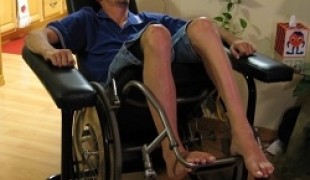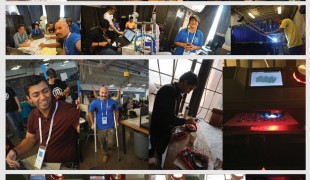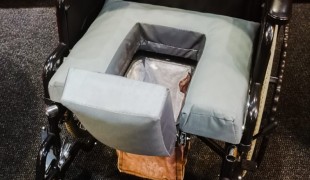- 8909
- 523
- 12
- 10
- 0
- Help Ukraine
About the solution
After designing a custom footrest for his wheelchair, Eric decided to improve it by adding bumpers. The first bumpers he designed were an improvement on what the manufacture had done to his footrest. However they were very tiny and did not offer much protection. So he decided to replace the tiny wheels in the corner of the footrest with much larger roller-skate wheels. These larger wheels, in addition to offering more protection to his feet and the walls also looked much nicer on the chair.
This bumper is a bit like a spare parachute for a sky-diver. It is good to have, but you should hope never to use it. He ran into a few walls since attaching these wheels and what the bumper tends to do is if you hit a wall at an angle, most times it pushes the front end of the chair over without leaving marks on walls. It offers some protection to the feet in a direct hit of a wall, but not much. Primarily, these bumpers will protect what your hitting, and not you... but at the same time, they offer enough protection that he personally thinks they ought to be standard equipment on all wheelchairs.
Adapted from: http://bit.ly/2kjREFo
这些解决方案不应包括使用药物,化学品或生物制品(包括食品);创伤性设备;冒犯性的,商业或内在危险的内容。该解决方案未经医学验证。请谨慎进行!如果您有任何疑问,请咨询健康专家。
DISCLAIMER: This story was written by someone who is not the author of the solution, therefore please be advised that, although it was written with the utmost respect for the innovation and the innovator, there can be some incorrect statements. If you find any errors please contact the patient Innovation team via info@patient-innovation.com
-
-
565
-
0
-
9429

Wheelchair Accessible Recliner
MOVING IN A WHEELCHAIR: Moving using a wheelchair.
CAREGIVING
Cervical spinal cord injury/Tetraplegia
Walking Aid (wheelchair/walker/crutches)
Managing pain
Promoting self-management
Preserving Organ Function
Promoting inclusivity and social integration
Maintaining Balance and Mobility
Restoring Blood Circulation
Preventing (Vaccination, Protection, Falls, Research/Mapping)
Internal Medicine
Neurology
Orthopedics
Rheumatology
United States
-
-
-
688
-
1
-
13053

Carry Crutches – Cup holder for people who use crutches
WALKING WITH A WALKING AID: Walking with a walking aid
(SELF)-CARE: DRINKING: Drinking independently.
3d Printed
Walking Aid (wheelchair/walker/crutches)
Promoting self-management
Promoting inclusivity and social integration
Maintaining Balance and Mobility
Preventing (Vaccination, Protection, Falls, Research/Mapping)
Internal Medicine
Neurology
Orthopedics
Rheumatology
Solutions for Disabled people
United States
-
-
-
370
-
0
-
3909

The PARA-TUBE
(SELF)-CARE: USING THE TOILET: Using the toilet independently
MOVING IN A WHEELCHAIR: Moving using a wheelchair.
Bone Disorders (Decalcification, Bone Deformity, Bone Fracture, Bone Infection)
Spinal Cord and Nerve Root Disorders
Walking Aid (wheelchair/walker/crutches)
Assistive Daily Life Device (to help ADL)
Difficulty walking or moving
Gait abnormalities (e.g., walking difficulties, unsteady gait)
Difficulty coordinating movements
Stiffness or rigidity (difficulty moving)
Paralysis of the legs and lower body
Muscle weakness
Limited range of motion
Muscle pain or stiffness
Muscle cramps or spasms
Promoting self-management
Maintaining Balance and Mobility
Preventing (Vaccination, Protection, Falls, Research/Mapping)
Neurology
Orthopedics
Physical Medicine and Rehabilitation
Rheumatology
South Africa
-
 zh
zh